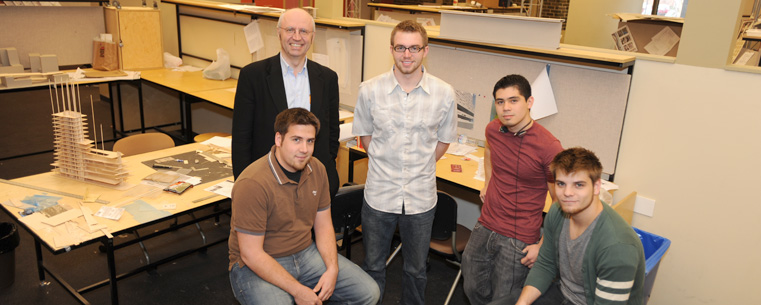Recent Success Stories
- New Kent State President Embarks on Listening Tour
- Scholar Helps Fight Crime With Violence Prevention Research
- Welcome, President Warren
- Destination
Kent
State
Returns - Now Serving More Than 300 Student Organizations
- Visit Kent State
- Kent State Captures Eighth Jacoby Trophy
- Scholar Supplies Global Technology Knowledge to Students

Reaching
New Heights
This semester, four Kent State University architecture students are in the process of creating an iconic structure as they participate in the Student Titanium Pedestrian Bridge Design Competition, sponsored by the North Canton-based Defense Metals Technology Center (DMTC) and the University of Akron.
The competition was open to universities with departments and schools of architecture, civil engineering and industrial design located in Ohio, western Pennsylvania, northern West Virginia, northern Kentucky, eastern Indiana and southeast Michigan.
Senior team members Joe Grescovich, Ben Grimm, Amadeus Escudero and Travis Vannoy have qualified for the competition finals. The team’s faculty advisor is associate professor of architecture and urban design Maurizio Sabini.
A total of five teams were selected for the finals. Other universities who qualified with Kent State are Ball State University, Miami University and the University of Akron. One unnamed university qualified two teams.
The Kent State team took its first steps in November 2009 as they worked from the ground up by researching different structures and designs.
“We collaborated on a lot of ideas together,” Grescovich said. “We took it as a step-by-step process as a team and divided tasks evenly. We studied aircraft because of their titanium use and conducted tons of research on other pedestrian bridges.”
The competition’s design is focused on a pedestrian bridge that will link Akron’s Quaker Square Inn, which serves as a residence hall, hotel and conference center, to the University of Akron. This area is currently divided by railroad tracks that force pedestrians to use other bridges or means of transportation to access the main campus.
Sabini said the bridge will help develop the university.
“The overall goal for the pedestrian bridge is to improve the connectivity of the campus,” Sabini said. “The approach of our team was to look at the bridge not as an object in itself, rather as an element of a broader urban design strategy for the campus.”
The team said a bridge design may seem simple, but there are a lot of detailed components to look at.
“The purpose is to come up with an iconic piece on campus,” Vannoy said. “We had to be conscious of urban development with every move we make.”
“You have to take environmental, economical and social context all into consideration, rather than just design,” Grescovich said. “One simple move can make a lot of changes.”
Though this competition is not worth course credit, Sabini said the experience is rewarding.
“This is a good way for students to scope in a fun experience,” Sabini said. “Our senior students have a good set of design skills and sufficient knowledge of structural issues for such a design task. These individuals have done a phenomenal job. They followed a thorough design process and explored different options and fills through internal debates.”
Finalists will present their entries to judges on April 14. Judges will announce the first-place and second-place winners, along with three designated as honorable mentions at a reception on May 20.
Students on each team will receive scholarship money from the DMTC, and grants will be awarded to each institution to study specialty metals in commercial applications. Grants and scholarships will both range from $1,000 to $5,000.

Facebook
Twitter
Google+
LinkedIn
Instagram
YouTube
More Ways to Connect